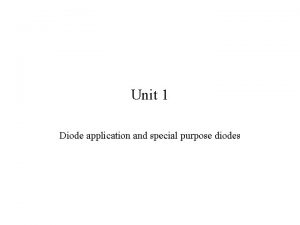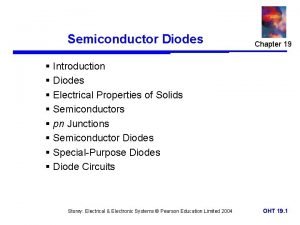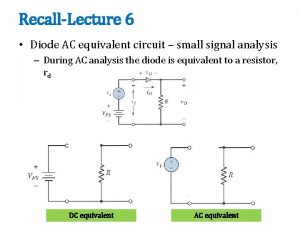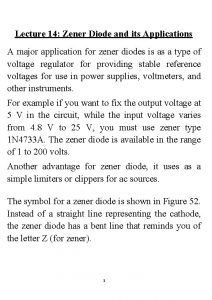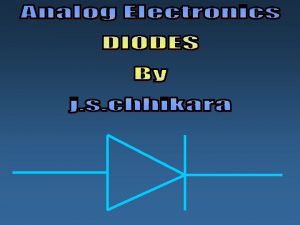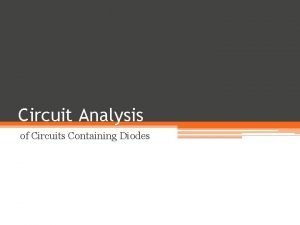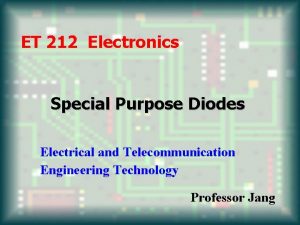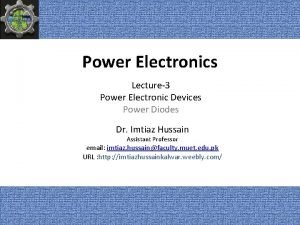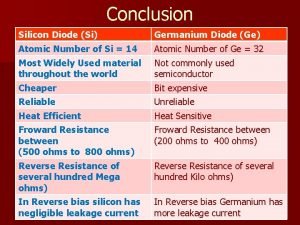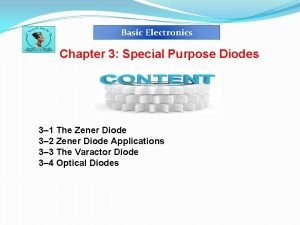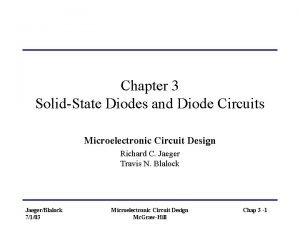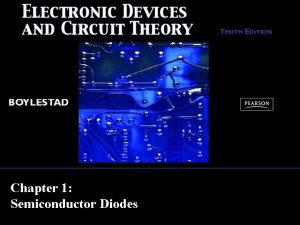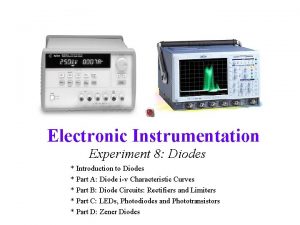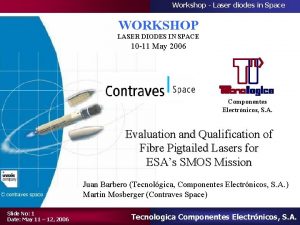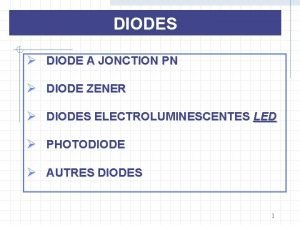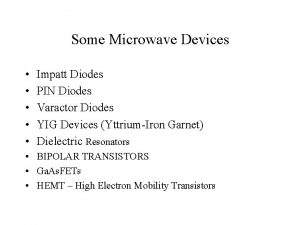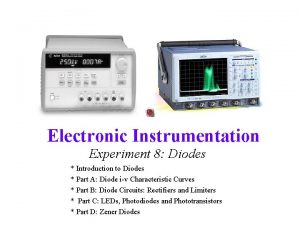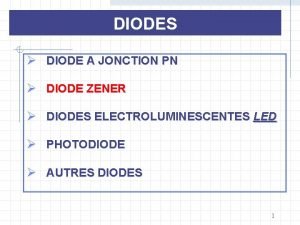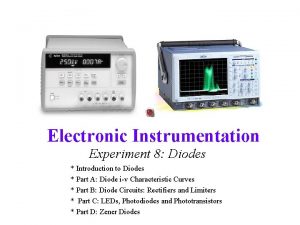DIODES http www vidyarthiplus com What Are Diodes













- Slides: 13

DIODES http: //www. vidyarthiplus. com

What Are Diodes Made Out Of? • Silicon (Si) and Germanium (Ge) are the two most common single elements that are used to make Diodes. A compound that is commonly used is Gallium Arsenide (Ga. As), especially in the case of LEDs because of it’s large bandgap. • Silicon and Germanium are both group 4 elements, meaning they have 4 valence electrons. Their structure allows them to grow in a shape called the diamond lattice. • Gallium is a group 3 element while Arsenide is a group 5 element. When put together as a compound, Ga. As creates a zincblend lattice structure. • In both the diamond lattice and zincblend lattice, each atom shares its valence electrons with its four closest neighbors. This sharing of electrons is what ultimately allows diodes to be build. When dopants from groups 3 or 5 (in most cases) are added to Si, Ge or Ga. As it changes the properties of the material so we are able to make the P- and N-type materials that become the diode. Si +4 Si +4 Si +4 The diagram above shows the 2 D structure of the Si crystal. The light green lines represent the electronic bonds made when the valence electrons are shared. Each Si atom shares one electron with each of its four closest neighbors so that its valence band will have a full 8 electrons. http: //www. vidyarthiplus. com

N-Type Material: +4 +4 +5 +4 +4 When extra valence electrons are introduced into a material such as silicon an n-type material is produced. The extra valence electrons are introduced by putting impurities or dopants into the silicon. The dopants used to create an n-type material are Group V elements. The most commonly used dopants from Group V are arsenic, antimony and phosphorus. The 2 D diagram to the left shows the extra electron that will be present when a Group V dopant is introduced to a material such as silicon. This extra electron is very mobile. http: //www. vidyarthiplus. com

P-Type Material: +4 +4 +3 +4 +4 P-type material is produced when the dopant that is introduced is from Group III elements have only 3 valence electrons and therefore there is an electron missing. This creates a hole (h+), or a positive charge that can move around in the material. Commonly used Group III dopants are aluminum, boron, and gallium. The 2 D diagram to the left shows the hole that will be present when a Group III dopant is introduced to a material such as silicon. This hole is quite mobile in the same way the extra electron is mobile in a n-type material. http: //www. vidyarthiplus. com

The PN Junction Steady State 1 Na P ionized acceptors Metallurgical Junction Nd - - - - - - + + + + + + - - - + + + n Space Charge Region ionized donors E-Field + + h+ drift = h+ diffusion _ _ e- diffusion = e- drift http: //www. vidyarthiplus. com

The PN Junction Steady State When no external source is connected to the pn junction, diffusion and drift balance each other out for both the holes and electrons Space Charge Region: Also called the depletion region. This region includes the net positively and negatively charged regions. The space charge region does not have any free carriers. The width of the space charge region is denoted by W in pn junction formula’s. Metallurgical Junction: The interface where the p- and n-type materials meet. Na & Nd: Represent the amount of negative and positive doping in number of carriers per centimeter cubed. Usually in the range of 1015 to 1020. http: //www. vidyarthiplus. com

The Biased PN Junction Metal Contact “Ohmic Contact” _ (Rs~0) P + Applied Electric Field n I + _ Vapplied The pn junction is considered biased when an external voltage is applied. There are two types of biasing: Forward bias and Reverse bias. These are described on then next slide. http: //www. vidyarthiplus. com

The Biased PN Junction Forward Bias: In forward bias the depletion region shrinks slightly in Vapplied > 0 width. With this shrinking the energy required for charge carriers to cross the depletion region decreases exponentially. Therefore, as the applied voltage increases, current starts to flow across the junction. The barrier potential of the diode is the voltage at which appreciable current starts to flow through the diode. The barrier potential varies for different materials. Reverse Bias: Under reverse bias the depletion region widens. This Vapplied < 0 causes the electric field produced by the ions to cancel out the applied reverse bias voltage. A small leakage current, Is (saturation current) flows under reverse bias conditions. This saturation current is made up of electron-hole pairs being produced in the depletion region. Saturation current is sometimes referred to as scale current because of it’s relationship to junction temperature. http: //www. vidyarthiplus. com

Properties of Diodes Figure 1. 10 – The Diode Transconductance Curve 2 ID • VD = Bias Voltage (m. A) • ID = Current through Diode. ID is Negative for Reverse Bias and Positive for Forward Bias IS VBR ~V VD • IS = Saturation Current • VBR = Breakdown Voltage • V = Barrier Potential Voltage (n. A) http: //www. vidyarthiplus. com

Properties of Diodes The Shockley Equation • The transconductance curve on the previous slide is characterized by the following equation: ID = IS(e. VD/ VT – 1) • As described in the last slide, ID is the current through the diode, IS is the saturation current and VD is the applied biasing voltage. • VT is thermal equivalent voltage and is approximately 26 m. V at room temperature. The equation to find VT at various temperatures is: k = 1. 38 x 10 -23 J/K VT = k. T q T = temperature in Kelvin q = 1. 6 x 10 -19 C • is the emission coefficient for the diode. It is determined by the way the diode is constructed. It somewhat varies with diode current. For a silicon diode is around 2 for low currents and goes down to about 1 at higher currents http: //www. vidyarthiplus. com

Dynamic Resistance The dynamic resistance of the diode is mathematically determined as the inverse of the slope of the transconductance curve. Therefore, the equation for dynamic resistance is: r F = V T ID The dynamic resistance is used in determining the voltage drop across the diode in the situation where a voltage source is supplying a sinusoidal signal with a dc offset. The ac component of the diode voltage is found using the following equation: v. F = vac r. F + R S The voltage drop through the diode is a combination of the ac and dc components and is equal to: VD = V + v F http: //www. vidyarthiplus. com

Dynamic Resistance Example: Use the same circuit used for the Q point example but change the voltage source so it is an ac source with a dc offset. The source voltage is now, vin = 6 + sin(wt) Volts. It is a silicon diode so the barrier potential voltage is still 0. 7 volts. RS = 1000 ID + vin v. F = vac V + The DC component of the circuit is the same as the previous example and therefore ID = 6 V – 0. 7 V = 5. 2 m. A 1000 r. F = VT = 1 * 26 m. V = 4. 9 ID 5. 3 m. A = 1 is a good approximation if the dc current is greater than 1 m. A as it is in this example. r. F = sin(wt) V 4. 9 = 4. 88 sin(wt) m. V r F + RS 4. 9 + 1000 Therefore, VD = 700 + 4. 9 sin (wt) m. V (the voltage drop across the diode) http: //www. vidyarthiplus. com

Types of Diodes and Their Uses PN Junction Diodes: Are used to allow current to flow in one direction while blocking current flow in the opposite direction. The pn junction diode is the typical diode that has been used in the previous circuits. A K Schematic Symbol for a PN Junction Diode Zener Diodes: P n Representative Structure for a PN Junction Diode Are specifically designed to operate under reverse breakdown conditions. These diodes have a very accurate and specific reverse breakdown voltage. A K Schematic Symbol for a Zener Diode http: //www. vidyarthiplus. com
 Antigentest åre
Antigentest åre Dậy thổi cơm mua thịt cá
Dậy thổi cơm mua thịt cá Cơm
Cơm Special purpose diode
Special purpose diode Introduction to diodes
Introduction to diodes Equivalent circuit of zener diode
Equivalent circuit of zener diode What is zener diode explain its applications
What is zener diode explain its applications What are diodes
What are diodes Circuit analysis with diodes
Circuit analysis with diodes Special purpose diodes
Special purpose diodes Switching characteristics of power diode
Switching characteristics of power diode Silicon and germanium diode
Silicon and germanium diode Special purpose diodes
Special purpose diodes Diode current flow
Diode current flow



